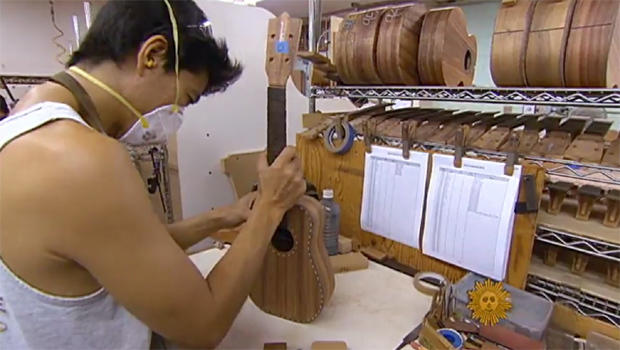The ukulele gets respect
(CBS News) Playing the ukulele is a lot of fun. And playing it very, very well is harder than many people might think. Here's Seth Doane:
This report was originally broadcast on October 14, 2012.
So much sound, from just four strings.
In the skilled hands of Jake Shimabukuro, the ukulele is transformed.
The 36-year-old virtuoso picked up the instrument when he was just four, and as a young man was relegated to performing at weddings and coffee shops . . . until a certain video first hit YouTube in 2005.
He still has no idea who posted his rendition of George Harrison's "While My Guitar Gently Weeps."
"I was just like, 'Oh my gosh, this is crazy. You know, what this is?' And back then my name wasn't even on this video. It was just 'Asian ukulele player,' " he laughed.
Grabbing more than 10,000,000 hits to date, YouTube says it's one of its first "viral" videos.
From his home base in Hawaii, Shimabukuro -- who plays many different types of music, from classical to jazz to blues -- has become an ambassador of sorts for the instrument. And no question it needed a little help . . . remember Tiny Tim?
At the University of Hawaii, Doane met Jim Tranquada, a ukulele historian -- his great-great-grandfather made some of the first ukuleles in this last state to join the union.
Doane asked, "Historically speaking, why has the ukulele gotten so little respect?"
"It's small, so it's easy to pick on," Tranquada replied. Plus, "it's always been marketed as the instrument that 'anyone can play -- you don't have to have any knowledge of music.' "
And while many may think of the ukulele as distinctly Hawaiian, it's originally a Portuguese instrument, from the tiny island of Madeira, off the coast of Morocco.
They were brought to Hawaii by Portuguese immigrants in 1879. At the time, the Hawaiian Gazette referred to them as "strange instruments . . . a cross between a guitar and a banjo."
But Hawaiians quickly adopted what was originally called a "machete" and began crafting the ukulele out a native wood, called koa.
That tradition is carried on at Kamaka, where a four-generation family business still makes the ukulele from that now-trademark koa wood.
"If you're going to pick up a Kamaka, you're picking up one of the best," said Casey Kamaka. The grandson of founder Samuel Kamaka Sr., Casey does the custom detail work.
This factory once employed a number of deaf people, because folks here believed the secret to perfecting these instruments was in how the wood vibrated. It was a concept taught by Casey Kamaka's father.
"You couldn't hear anything anyway 'cause the machines were so loud," Casey Kamaka told Doane. "And so what they did was [teach] them how to feel the wood. So when he found one that was the right pitch or right sound, he gave it to them and said, 'This is what I want.' "
Today, their ukes are priced from around $800, to more than $5,000 for custom ones -- like those designed by Jake Shimabukuro.
In Hawaiian, the words "uku" and "lele' mean "flea" "jumping," and it's no mystery why the name stuck -- your fingers jump from string to string.
But not everyone's. Take, for instance, the slowest-ever rendition of "Tiny Bubbles" by Seth Doane. Roy Sakuma, Shimabukuro's one-time teacher, assured him that he could learn to play in just a few minutes.
Jake Shimabukuro says that when people see the ukulele, or see others playing it, "They immediately think, 'Oh, that looks like fun, I can do that. Let me try!' "
This instrument seems even more fun in a place like Hawaii . . . where the ukulele provides the perfect soundtrack to paradise.
For more info:
- jakeshimabukuro.com
- "The Ukelele: A History" by Jim Tranquada (University of Hawaii Press)
- Kamaka Hawaii, Honolulu

